At the YWP
This week, we again visited the Yorkshire Wildlife Park. My fourth post (1.4.25) focused on the cold temperatures of that first visit on December 30th.
This time the weather was gloriously comfortable! And the focus will be on the animals. YWP is home to some 400 animals of 70 different species. Many of them are endangered or threatened.
Sealions–the first animals on the tour–are most memorable—especially at feeding time! As it nears, they look expectantly toward the small building from whence comes the food.
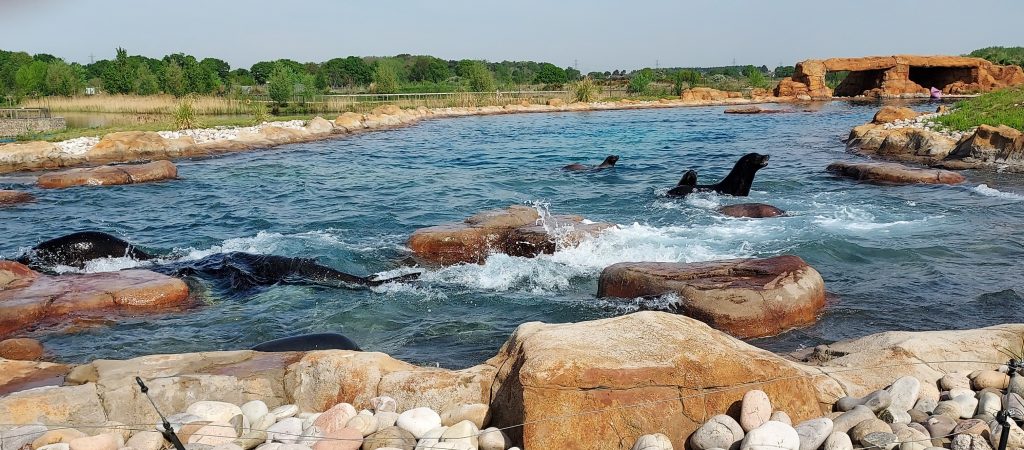
When the feeders come in sight, the beasts become very excited. Then the fish come flying through the air at them, the feeding frenzy begins! They thrash and churn the water as they each catch as many as possible.

Such an exciting spectacle of joyful, competitive energy!
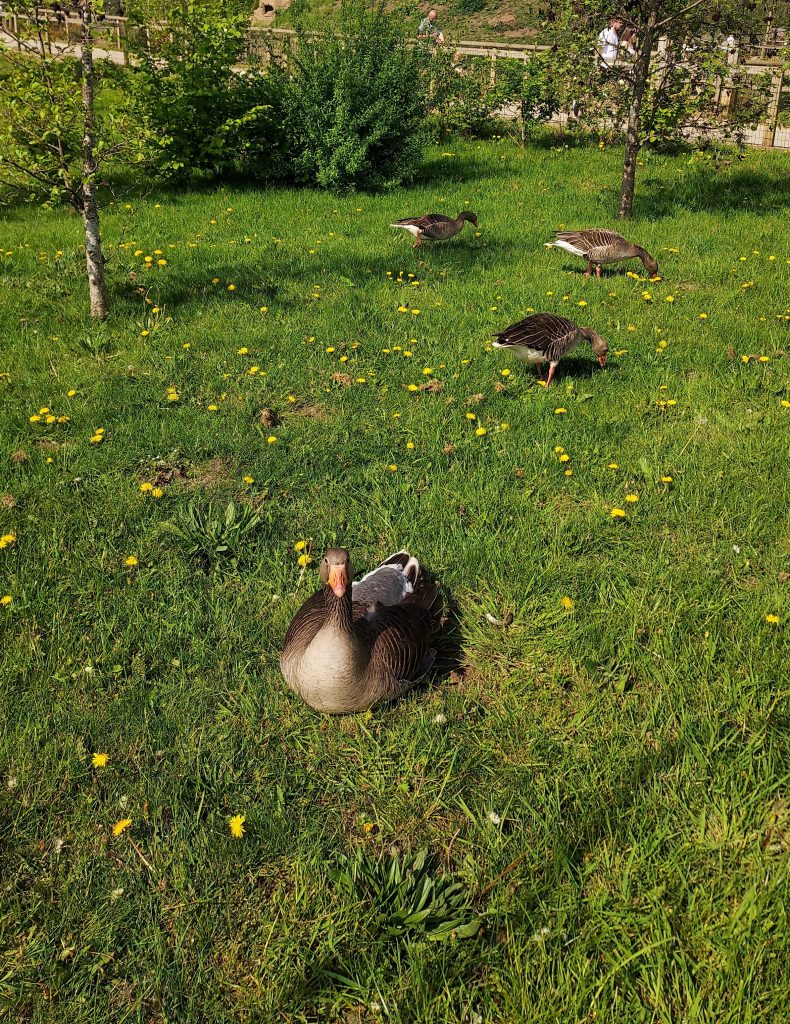
The next notable animal was the Graylag Goose. Although six searched a green field for food, this mature and majestic one stoically sat viewing the passersby as much as it was being viewed. The Graylag Goose is the ancient ancestor of the modern white goose often seen in movies. It is the only wild goose that sports an orange bill like its snowy descendent.
Four polar bears could be seen. While one enjoyed cooling off in a nearby pond, two paced about the enclosure. But this giant sunned himself undisturbed by all the gawking visitors. They roam on a ten acre reserve at YWP, one of the world’s leading centers for polar bear welfare and conservation.
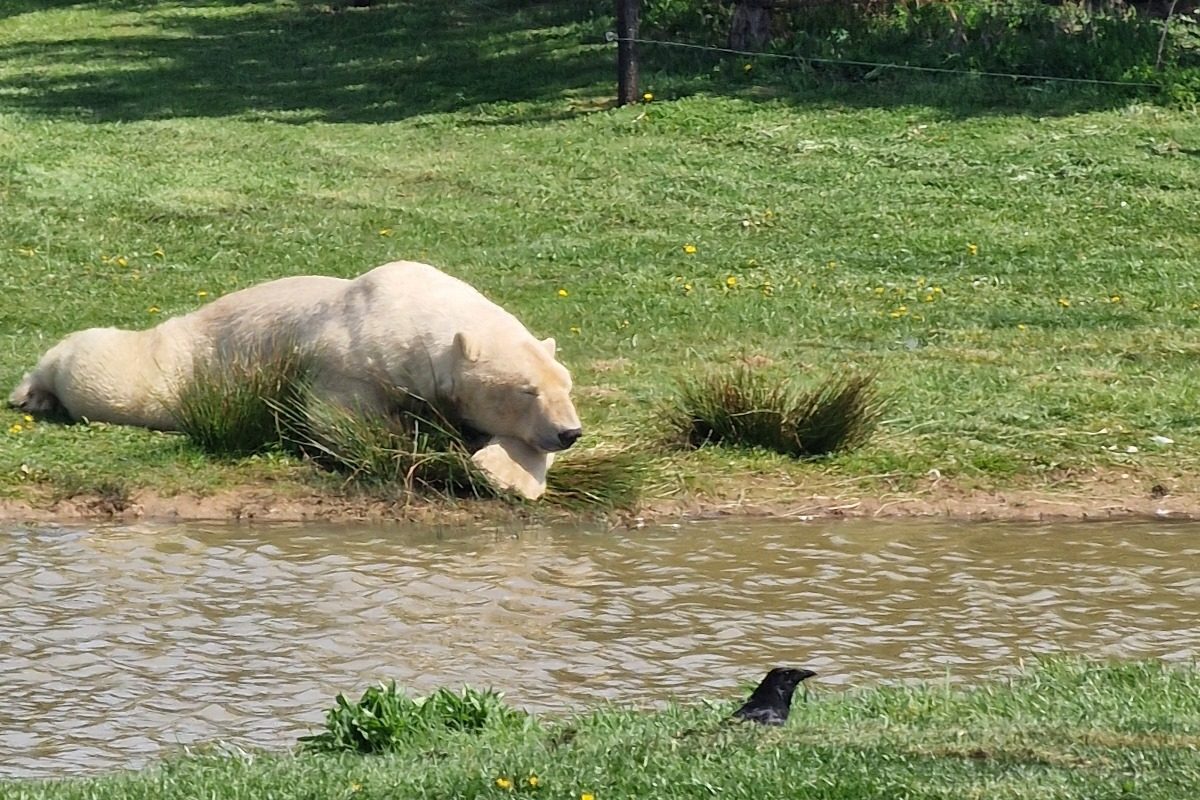
Two smaller animals often overlooked are the meercat and the warty pig. Seeming like underdogs to me, they pulled on my heart strings.
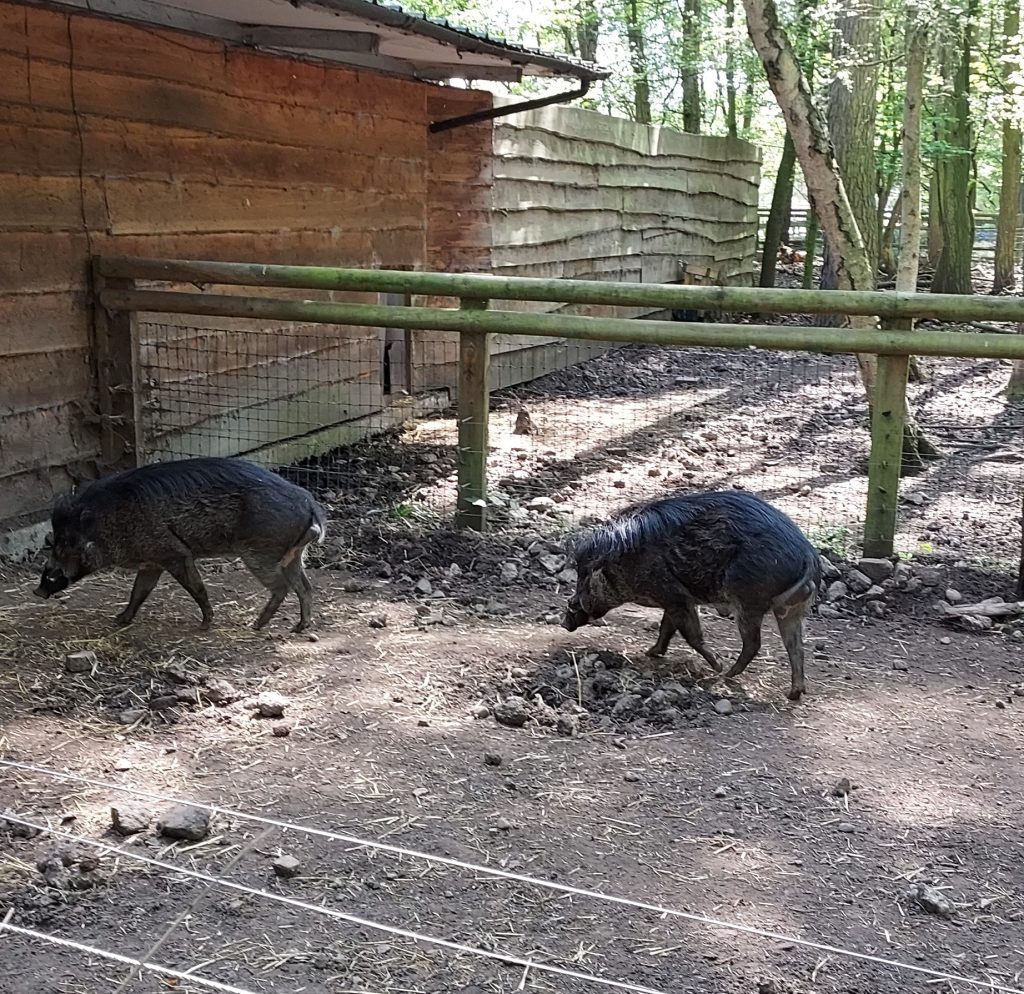
The Visayan Warty Pig, comes from the Philippine Islands. It is one of the most critically endangered species, having lost 98% of its former wild range. “These pigs often stay in small groups with the male living away from his female partner and their litter. Male Visayan warty pigs have fantastic spiky hair with an iconic crest.”
I had never heard of the meercat until I saw the Lion King back in 1994. (Wow! 31 years ago1) This scout, atop a mound of dirt and rock, diligently keeps a watchful eye over its enclosure.
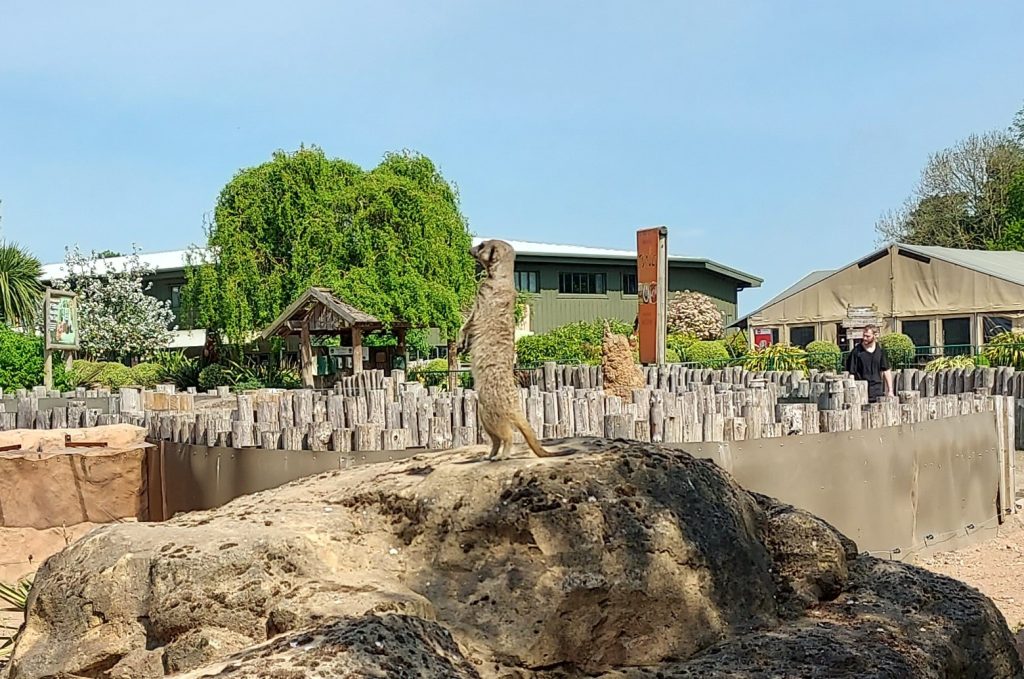
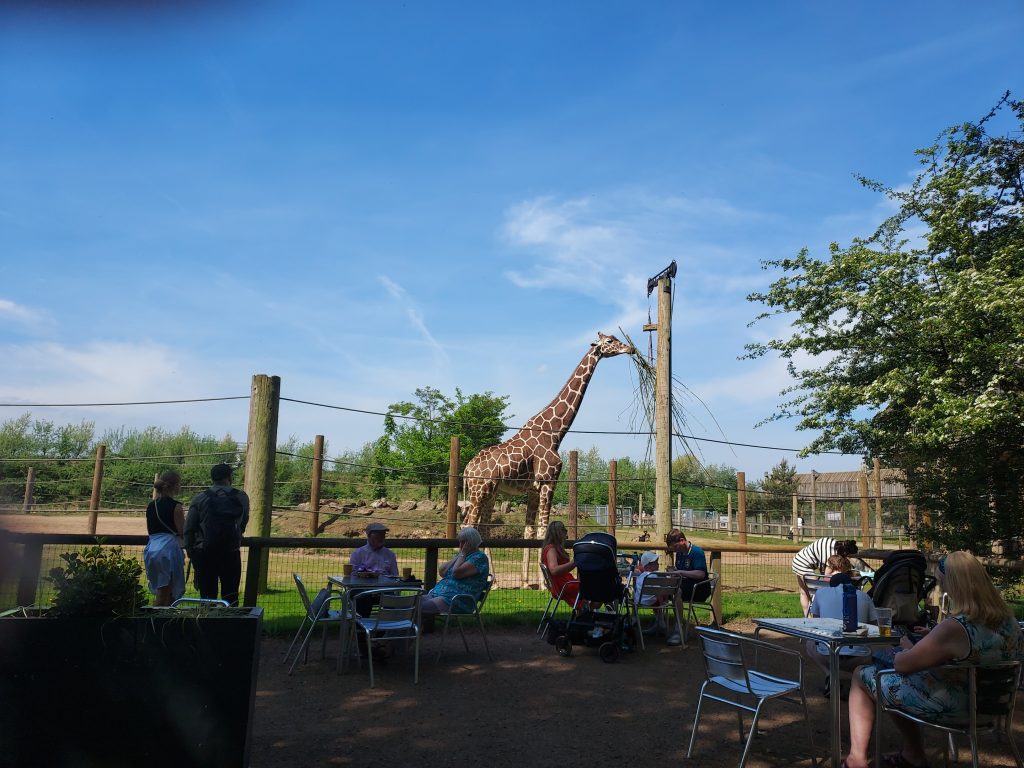
The tall, gentle, royal giraffe is one of my favorite animals. Of course, its stature and incredibly long neck as well as its coloration are stunning. But its large, brown, gentle eyes really attract me. Reading West with Giraffes by Lynda Rutledge, deepened my appreciation for this noble creature.
There’s so much to see at Yorkshire Wildlife Park that it makes a good one-day trip. There are several such parks throughout England; so, I wonder how many wildlife parks are in the USA.
I know of Oregon’s Wildlife Safari south of Roseburg, but I know of no others in the country. Surely, there are some. Do you know of any and in which states they are? When I asked Google, “How many wildlife parks are in the US?” the response was always about national parks.
Is it possible that the small kingdom of the British Isles have more wildlife parks than America?
Hakuna Matata Linda. Now I’m curious about the wildlife parks in America. Blessings to you. Deb
Always a pleasure to hear from you, Deb.
God’s blessings, my love–Linda
Thanks for taking the time and effort to take us with you on your incredible adventures. Getting back home may seem a bit dull for a while. Love, Shirley
Always a pleasure to hear from you, Shirley.
God’s blessings, my love,
Linda
There’s Northwest Trek Wildlife Park near Enumclaw, Washington.
Good to know that you read my posts. Thanks for the website to America’s wildlife parks. It’s interesting that most of them lie in the eastern half of the country and only four in the 11 western states, which comprise a third of the country’s size. Considering the size of England, it’s rather remarkable that it has several such parks.
Here are a few more:
https://studenttravel.pro/stem/top-10-safari-parks-in-the-us/
I’m currently in Zihuatanaho Mexico & we visited a “wildlife rescue” center today. We saw a tiny porcupine with 2 babies, a raccoon, also very small, a small warthog, a bunch of iguanas and some hummingbirds..it was enlightening in a way to see so few animals because it meant there were less lives to be saved. There was a little spider monkey that will be traveling to Alabama soon, under the radar of federalities, to his new home. I would post a pic but can’t find a way to do so here!
I didn’t know that a trip to Mexico was in your plans.
I didn’t know that a trip to Mexico was in your plans. When and why did you begin your planning? Who is with you there?
When we get together, we each will have big trips to share. That will be fun.
I’m scheduled to fly home in just five weeks, and I am looking forward to seeing you then. 😉
Greetings!
A more enjoyable time of the year makes all the difference in an interesting repeated adventure! In my less than in-depth research, I learned there were some seventeen so called Wildlife Safari sites around the USA (Washington/Oregon/California/Arizona/Florida…). However, some could be a combination of zoo and acres of roaming wild animals. Also, I believe the Visayan Warty Pigs you observed were originally from Visayas Island in the Philippines. I didn’t see any there when traveling, but many distant cousins of those (Suidae) are in Greece, Crete, etc., but are not related to the javelinas in Arizona. The VWP you ‘felt-for’ are probably endangered because the Visayans eat them!
If you ever go near Chardstock, Devonshire, that’s where my maternal side of the family is from. They built the inn and church there. It was so exciting and interesting to see! My mom & I found a set of pewter measuring cups in their ‘fruit room’ with my great, great, great grandfather’s initials carved on the bottom and a bone-handle carving set – mom bought them of course!!!
Enjoy every moment of your final month there with your dear Katie and Ian/Rick!!!
I love your enthusiastic feedback. I meant to include in my post about YWP that this particular warty hog comes from the Philippines, but I totally forgot. Thanks for filling in that blank and for all of your comments.
I know that we will not be going to Devonshire in southern England. It’s too far to drive, and Katie is the one who does all the driving out of necessity. The distance would require at least one night in a motel. She and I, however, are going to take a day=trip by train to see one of my former international boarders in London.
Looking forward to further conversations.